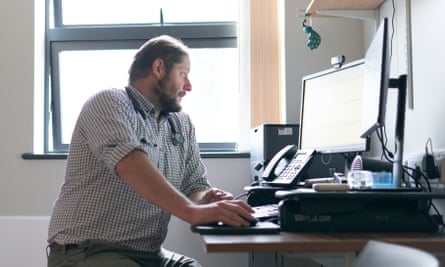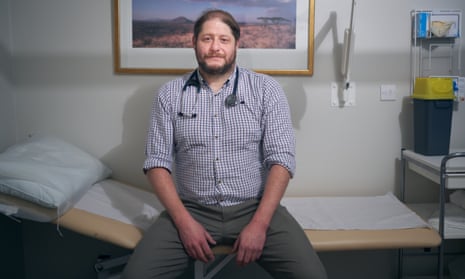Last week, I went to Gloucester to see a doctor. I was armed with headlines that placed the city and its surrounding county at the sharpest end of the current crisis in general practice. More than 30,000 patients in Gloucestershire had to wait more than a month for a GP appointment in September, a figure that had doubled in a year. Meanwhile, since the pandemic, doctors and nurses and reception staff have been leaving jobs and partnerships in unprecedented numbers. (There is a current shortfall of at least 4,200 GPs across England, with notable gaps in the south-west.)
Dr Bob Hodges, a veteran of the frontline of primary care, had invited me to his Gloucester practice to witness the more complicated reality behind those headlines. Hodges is a big, gentle man with an easy smile, one of nine partners at the Aspen medical practice near the centre of the city, and vice-chair of the local medical committee that represents the county’s GPs. He wears hospital scrubs because he doubles as a subspecialist in dermatology doing minor operations. He gets in early. “Either it’s paperwork before patients or vice versa,” he says, “and we have a late clinic until 8pm so usually I’m too knackered to do the admin after the last patient.”
Hodges became a GP in 2008. He trained as a pathologist but recalls thinking, at about the moment he became a father for the first time, that he would far rather deal with the quick than the dead. “Treating the whole person was better than looking at one of its parts under a microscope.”
Before we get to his patients, he sits me down in his consulting room and gives me a brisk diagnosis of some of the problems facing doctors across the county and the country as we head into another long NHS winter. To begin with, there are the numbers. Covid hasn’t helped, but it isn’t just Covid. “If you increase the age of the population by five years, the data suggests you need to roughly double the available health care,” he says. “But what have we done?” (Answer: according to the latest figures from the BMA there are 1,808 fewer full-time GPs in England today than there were in September 2015, while each practice has on average 2,131 more patients). Meanwhile, Hodges notes, demand for primary health services only ever rises. His practice’s NHS contract assumes about three and a half contacts with each patient each year; there are currently about seven annual contacts. “So: double.”
Those headline waiting list outrages, he says, and the vitriolic tabloid campaigns for more face-to-face consultation, wilfully miss several points. “At the moment if you really need to see a GP in a day or two you invariably will. But if it can wait, it must wait.” The Aspen practice has just over 30,000 patients on its books; on any given Monday, like today, 1,000 of them will be in clinical contact with the surgery; at 9am the queues are forming, the phones are backed up and emails with URGENT subject headings are flooding in. Prioritisation, telephone consultations, four-week non-urgent bookings are a necessity rather than a choice. “When politicians stand up and make another promise that ‘your doctor will be legally obliged to see you in a week’ or whatever,” Hodges says, “They are either making a promise about my nonexistent time or this practice’s nonexistent money. They have no right to do either.”

The Aspen partnership merged five smaller practices in a purpose-built complex, in common with trends across the country, to give it the scale to create specialist teams and to spread risk. “There is,” Hodges says, “always the threat in small partnerships of being the last man standing; if you are in a partnership of two and your partner resigns then you have all the financial liability of an asset you are not allowed to sell.”
That’s one of the reasons there are so few takers. When Hodges got his first salaried GP job there were 50 applicants. Today, all the local GPs I speak to insist that you could pretty much walk into any practice in the county and be hired on the spot. Not surprisingly, young doctors often prefer a few days a week as a contracted locum without the pressure of also being responsible – as here – for the management and livelihoods of 140 staff. The result is a kind of perfect storm of stress on the traditional partnership model – a recent Royal College of General Practitioners survey found that 42% of GPs in England were “likely or very likely to leave the profession in the next five years”, with nearly half of those suggesting burnout or stress as the prime reason.
“It’s the boiling frog analogy,” Hodges says. “The water’s not been comfortable for a decade, but it’s now very noticeably warmer. It will soon reach a threshold where there is a collapse.”
If all that sounds despairing, Hodges then opens his doors, as he does every working morning, to offer the everyday hope of consultation. Aspen has moved to 15-minute appointments (from the NHS regular 10), because it accepts “that most people will come with a list and it makes sense to look at everything”. I sit quietly in the corner and, with consent, observe that still sacred confessional between GP and patient. Looking on, it is hard not to see almost every case as a brief essay on the state of the nation.
First is a little boy who has been referred by his school as having ADHD. He sits quietly on his father’s lap, holding a Batman figure, staring at the doctor. He is four years old. The boy’s parents clutch at a referral to a child mental health system that is ludicrously overwhelmed. “Maturity is a variable thing,” Dr Hodges reassures them, “and he’s just spent a lot of his formative years locked down.”
Such referrals form a significant part of every GP’s workload at the moment, he says, when the family has gone. Large areas of childhood behaviour have been medicalised. Parents expect answers. “Classic mental health issues such as psychosis, bipolar disorder, that is probably 3 or 4% of the people we see,” the doctor says. “Everything else is related to external stress and anxiety.”
Next is a man who has recently suffered a debilitating stroke, but in a perfunctory external assessment has been declared fit for work, and so will lose his right to universal credit against the advice of the doctor and specialist. He’s not sure where to turn. Another letter is written, and while he is there, the doctor also treats him for dermatitis.
Then there is a man who has just been made redundant and has fallen off the wagon of a recommended diet for his type 2 diabetes. There are various related problems – knee and back pain, insomnia, high blood pressure. The doctor gives him a gentle lecture on having spinach, not rice, with his curry – wonders about steroid injections in his knees and encourages his job prospects.
A few couples shuffle in with two-for-one intentions; the husband is concerned about his memory problems, the wife wants to talk to the doctor about her back spasms. Several have a shopping list of complex concerns. “How are you feeling?” “Where do I start, doctor?” And eventually the 15-minute slots give way to a series of phone consultations, one with a member of a Traveller family on the road in Essex. “In the past,” the doctor says of some of his lonelier and more troubled regulars, “they might have gone to see their vicar. Now they come to us.”
Watching Hodges with his patients, several of whom he has known for many years, is to be reminded of the original glue of the NHS – that comforting mythology of a family doctor. The week that I was in Gloucester marked the 70th anniversary of the Royal College of General Practitioners, founded in 1952 to “raise the quality and status of GPs”. The Guardian report of its creation noted that “it was generally felt that the hospital orientation of the health service had… obscured the fact that family practice is a subject with its own special art and knowledge.” The Lancet described it as an early Christmas present for the profession: “We regard the foundation of the college as a powerful psychological fillip for a group of men and women, too many of whom have lost heart.”

At the college’s threescore and 10, outgoing president Martin Marshall offers a sobering assessment of how the profession is bearing up. “There has to come a point,” Marshall says, “where doctors decide, I can’t do my job any more, and then the situation will spiral out of control. I would use the term crisis: so many parts of the NHS are under such enormous pressure that they are unable to provide the personal care that patients need, unable to provide effective care, and increasingly unable to even provide safe care.”
I’d taken in my bag to Gloucester a couple of books that spoke to the distance between the idealised doctor-patient relationship that we might all still hold in our heads and the often desperate reality of call-waiting and backed-up ambulances. Both books were set just up the A40 in the Forest of Dean and Wye valley. John Berger’s A Fortunate Man, written in 1967, is a poetic tribute to a heroic rural GP, Dr John Sassall, who embodied the selfless compassion of the early NHS. The second, A Fortunate Woman, by journalist Polly Morland, shortlisted for this year’s Baillie Gifford prize, is a wonderful update of Berger’s book, about the modern-day successor to Sassall struggling through the pandemic.
Morland’s portrait makes a powerful case for the older order of intimate continuity of care – before data-driven efficiencies emphasised transaction over interaction; a service that valued “talking to people, listening to their stories, every bit as much as clinical examination”. One spur to writing it, she later tells me, was witnessing her mother, suffering from Alzheimer’s, confronted by a different doctor every week. She found Berger’s book behind a bookcase when she cleared her mother’s house.
The anonymous inspiration of Morland’s book – who becomes a kind of emblematic GP everywoman – is Dr Rowena Christmas. I spoke to her about some of the book’s implications, and her current practice in Monmouthshire. She outlined the weight of medical evidence that supported Morland’s argument. “If you have an ongoing medical problem, you’re better to see the doctor that you’ve been seeing regularly. Studies that show that patients who’ve seen the same GP for a year or longer are 25% less likely to use out-of-hours services or be admitted to hospital in emergency, and have better outcomes in all sorts of ways.”
Dr Christmas, in the book and in person, could hardly be more positive about her vocation, but even so she fears the way of life she represents is under threat: “All I want to say is positive stuff about general practice,” she says, “but if I’m honest, I’m very worried about where we’re going to be in five years’ time. I’m seeing really good, strong practices folding and handing their contracts back. It is so relentless now. I start at seven and it’s very rare that I’m home before eight o’clock at night. My days still have amazing moments with long-term patients. If you haven’t got those magic moments, then the job is brutally hard.”
Part of this is the breakdown in secondary care. Christmas estimates that at least 20% of her workload is managing patients on interminable waiting lists. And it is a long time since she called an ambulance. “That’s not really functioning, so we usually have to drive patients to hospital.” Once there they are facing 12- and 14-hour waits in A&E. “Quite often at the moment,” she says, “I’ll turn up to work at half seven, and there’ll be a patient in the car park who has given up on the emergency department, and is waiting to bang on my door.”
There have, of course, always been pressures. She notes how the incoming president of the Royal College quoted from the minutes of its first meeting 70 years ago “about terrible shortage, and soaring inflation and whether general practice could survive”, but also, she says, “I do sometimes feel we are in possible dark last days of this way of doing things, and it really makes me feel sick to say that. And you know that if we lose general practice, we lose the NHS as we know it, with all the awful health inequalities that will follow.”
Doing my rounds of doctors in Gloucester past and present, it’s hard to dispute that conclusion. David Martin became a GP in 1976 and was Hodges’s predecessor and mentor before retirement; he now appraises younger doctors. One difference he notes is an understandable change in that reflexive “above and beyond” mentality. “When I came through medical school, we had grants. So I always felt that I really owed the health service. They paid for my training. Nowadays, doctors arrive in practice with debts of £100,000.” The vocation is immediately more of a transaction.

Rachel Rutter, who sits on the local medical committee with Hodges, has been a GP for more than 17 years in Stroud. She tells me how she has recently taken the sad step of resigning from her small partnership, because of the ongoing pressures of the role. The workload that has been growing for a decade and was exacerbated by the pandemic has just continued to increase, she says. “For a long time now, we have in essence been firefighting the daily triage list. So the whole model of how we worked as a small practice changed. What we worried about most in the pandemic was: who is being lost in all this madness? Where’s our routine care of our vulnerable patients? We’ve been trying to get back to ‘normal’, but we’ve still got triage lists of 80 patients a day. I did an on-call yesterday afternoon and finished at about quarter past eight having done no prescriptions, no letters, no results. You are left all the time with that horrible feeling: I’m missing patients that I would normally have phoned up to check in how they’re doing. That just feels a bit frantic and at times even unsafe.”
It was, even so, very hard to take the decision to give up the practice and the patients to which she has devoted her working life – she plans to work fewer hours as a locum. One factor, she recalls, was reading about the Surrey GP Gail Milligan, who took her own life in July aged 47. Milligan’s husband, Chris, described to the medical press how his wife had become overwhelmed by the 24-hour demands of her job. “Her mind was constantly on work. And she felt guilty for stepping away. She became a shadowy figure in our lives. She was at work for 12 to 14 hours, and when she got home she was working again.” Rutter is the mother of two teenage children. “When I read that,” she says, “It really hit me: I’m working those hours too.”
Back at the Aspen practice you see some of those stresses in numbers on a TV monitor. The monitor is high on the wall of the back room of the reception area where half a dozen women are answering phones. The screen gives them an idea of whether they are winning: 568 calls, it reads, 405 answered, 22 waiting, 28 minutes of estimated waiting time. It’s the flip side of “you are number 13 in the queue”. Every conversation begins with an apology: “No, you are not being awkward”; “We are very busy this afternoon” and ends with a decision – “You need to come in this afternoon”; “The first slot we have is 20 December”.
After his morning surgery Hodges is doing a stint in a room next to the telephones, fielding trickier queries from the calls, making sure patients get to see the right clinician – practice nurse, or doctor associate, or support team or specialist. Aspen partners do this triage on a rota. In front of Hodges is a bank of screens that allow him to pull up the records of any patient and check histories while making his judgments.
You have the sense that making 100 potentially hazardous decisions an hour takes its toll. It’s one of the reasons that it’s hard to retain reception staff, though most here have been in the job for several years. “The anger has got much worse,” Hodges says, “whipped up by parts of the press.” He shows me a report of an earlier call where a patient had screamed abuse.
That mindset, he suggests, “starts with the false promise that every bad outcome could have been avoided. Every illness has a cure. We live in a world where people are encouraged to judge public service only on what doesn’t get done, in the absence of any kind of analysis of what is being done or what is reasonable to expect.”

What is being done in the backrooms of the practice seems to me at first-hand like a model of impressive efficiency forever struggling to keep up. A team of clinical pharmacists at Aspen – “red hot on patient safety” – work on thousands of prescriptions a day. While Hodges fields queries about teenage mental health provision and genital herpes (“probably don’t encourage him to email a picture”), he talks me through a checklist of the ways the system could be made to work better – with far greater physical integration of specialist services in primary care, with major investment in community rather than hospital beds, with nurses and associate doctors more free to do routine operations, and with GPs given more authority to meet local needs.
Aspen has pioneered, for example, a “frailty team” to try to replicate the traditional continuity of connection with vulnerable patients that Morland argues for. Rachel Bucknell, a former district nurse, is the practice’s frailty matron, leading a team of three. “It’s like Challenge Anneka, without Lycra,” she says.
She left district nursing five years ago to set this up because that role had “become completely task-oriented. You couldn’t manage the whole patient.” Her team of three tries to be prime point of contact for hundreds of older patients with complex care needs. A lot of that is based on regular home visits. Some is fighting a patient’s corner. “We have a woman in her 90s with no family who has dementia, rheumatoid arthritis and is partially sighted. It has taken 18 months of constant pressure to get a community bed.” Sometimes it is trying to assist with those who most disrupt the system. “We have a case where the patient has called an ambulance 144 times and the police more than 200 times in the last month for no reason other than they are lonely.” Mostly though, it is trying to recreate for people that world “where you went to see the doctor every so often and sat in the waiting room – a social as much as a physical thing”. “Social prescription” is the buzz phrase.
Hodges points to such proactive interventions – along of course with funding to provide adequate staff across the service and retain them, and honest conversations about what is possible – to ease the burden on doctors and the emergency services. “I’ll give you one example of where we are,” he says, as he heads back over to his consulting rooms for the next round of patients in his evening clinic. “We had someone come for a vaccine last Saturday get halfway here from the bus stop and collapse in our car park. The hospital is literally over the road. We waited an hour and a quarter for an ambulance.”
Comments on this piece are premoderated to ensure discussion remains on topics raised by the writer. Please be aware there may be a short delay in comments appearing on the site.
This article was amended on 28 November 2022. An earlier version had cited an “unpublished BMA survey”. The survey was in fact published by the Royal College of General Practitioners











Comments (…)
Sign in or create your Guardian account to join the discussion